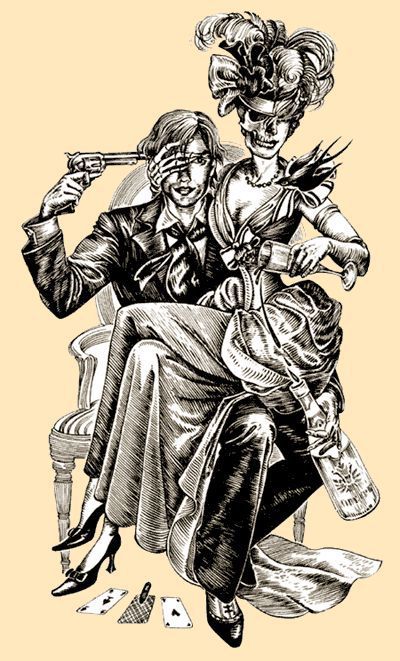All about russian roulette

Russian roulette is, perhaps, the most desperate and shocking game, putting the life at stake. The rules of this game were invented by officers of the tsarist army.
In 1871, the Russian army received the 1869 Smith-Wesson revolvers. Until 1876, Russia purchased about 130,000 Smith & Wesson revolvers (Smith-Wesson III) for the officers. They were also called the 4.2 linear or 10.67 mm revolvers. This was the beginning of the history of Russian roulette, a game overgrown with a great many legends and myths.
The classical rules of Russian roulette are as follows: revolver cylinder is charged with one round, after which it is spun. Thus, no one is able to guess where the bullet is located. After this, players place the muzzle of the gun against their forehead and pull the trigger one by one.
If a six-shot revolver is used, there is one bullet in the cylinder, but sometimes this rule is ignored, and the cylinder is charged with several rounds. Lethal combination is one empty place in the revolver cylinder. Sometimes, the cylinder is rotated after each turn, which significantly increases the player's chance to survive, but the result is less predictable still. There are less lethal versions of the game, when the muzzle is placed either against the hand, or even drawn aside.
The history of Russian roulette. Smith-Wesson revolver

Model III of 4.2-linear (10.67-mm) Smith-Wesson revolver
In America, the Smith-Wesson revolver is known as the №3 Russian First Model. There were three samples of Smith-Wesson revolvers, adopted in 1871, 1872 and 1880 years. They differed in the size of the barrels and minor changes in the details.
- Weight, kg: 1,20
- Length, mm: 300
- Barrel length, mm: 203/178/167
- Catridge: 44 Russian (44 Russian Smith-Wesson)
- Caliber, mm: 10,67 mm (The real caliber was 10,9 mm)
- Principle of action: single-action trigger
- Muzzle velocity, m/s: 200
- Ammo feed: a 6 shot cylinder
- Sight: trigger and trigger guard.
- A bullet of this revolver penetrated four pine boards with a thickness of 2.5 cm each from 20 m.
Initially, the game was called "hussar roulette" in Russia. There exist a number of legends about the appearance of the game. According to one of them, Russian roulette originated in the XIX century, when prisoners were forced to play Russian roulette and the guards bet on the results.
Another (more beautiful) legend says that Russian officers played Russian roulette to show their courage and fearlessness.
There was a war with the Ottoman Empire and officers, flirting with death, invented a new lethal game, which was no less risky than the war itself. There has been a respect for heroism, and there were plenty of examples. Mikhail Dmitrievich Skobelev, an outstanding military commander, awarded with a gold sword with diamonds for military operations in the Balkan Peninsula, was one of the most desperate generals. He is remembered in history as "White General", as he participated in battles in white uniform, mounted on a white horse, being an excellent target for the enemy. Why did he wear white? Skobelev was superstitious, followed the omens and presages. In one of the battles against the Turks Skobelev got contusion with a bullet. The general explained this by wearing a black sheepskin coat given by his father, and said that he from now will wear only white. Skobelev often risked his life and climbed out onto breastworks, throwing himself in front of enemy guns, but he seemed to be bewitched. The general committed many desperate acts and repeatedly went to attack at the head of troops.

It was strange to see such desperate actions and complete disregard for life against the background of raging wars. At the turn of the nineteenth and twentieth centuries, the life of the military wasn’t diverse and the officers were bored even during the war. Those who did not participate in battles, or had to wait for hostilities, went to the bad. Drinking, playing cards and brothels could not calm down the strong desire of youth for feats and recklessness.
Russian roulette was not just bravado - it was a duel, which was mercilessly punished. The loser was declared dead from the "stray bullet", if they were at the front, or a suicide, if there were no fighting nearby.
The Ottoman archives say that Russian officers who were taken prisoners during the Russo-Turkish war played roulette, striking the Turks with their desperation.
Teacher of the history in the Istanbul school Nihat Kaan says: "We first heard about Russian roulette in Turkey in the late nineteenth century, during another Russian-Ottoman war. There were records in the Ottoman archives proving this. In those years, the armies of many European armies were armed with brand new Smith Wesson revolvers. The captured Russian officers used to perform real shows with pistols. The prisoners twisted cylinders, and the Turkish corporals twisted a finger at the temple, thinking that it is another strange Russian tradition, like drinking vodka for breakfast ..."
The legendary Nagan was the next weapon of "Russian roulette" lovers.
Legendary Nagan - the next weapon of Russian roulette lovers
By the end of the XIX century, the Russian Empire had to begin mass rearmament of its army. The obsolete model of the 4.2-linear (10.67-mm) Smith-Wesson III revolver of 1880 was displaced. The revolver has never won love from the officers. It had good stopping power and was easy to reload, but was too heavy.
May 13, 1895 Nicholas II adopted a decree according to which the Russian army was armed with Nagans and Smith Wesson revolvers remained in service of the police. By July 20, 1914, the troops had 424,434 units of Nagan's revolver of all modifications.
Nagan is a revolver, developed by Belgian armourers brothers Emil and Leon Nagan.
7,62-mm Nagan revolver of 1895 year
- Weight without chambers, kg: 0,75
- Weight of the loaded revolver, kg: 0,835
- Length, mm: 235 mm
- Barrel length, mm: 114 mm (number of riffles 4)
- Chamber: 7,62 mm Nagan (Muzzle velocity, m/s 290)
- Lbs, J: 290
- Caliber, mm: 7,62 mm
- Principle of action: double action system
- Firing speed, shots/min: 14-21
- Muzzle velocity, m/s: 272
- Firing range, m: 50
- Maximum range, м: 250
Ammo feed: a 7 shot cylinder

At the beginning of the XX century, Russian roulette began to gain momentum. However, if earlier it was just bravado, now it became one of the most common versions of suicide. Nagan, on the wave of the idea of fatalism, was the answer to demanding tastes of most society members. Students, gymnasium students, pupils of military schools, cadets, young women, businesspersons, intellectuals, anarchists and many others tempted fate using a revolver. It was popular to play because of unrequited love, money, or just to test the luck, even at the cost of deadly risk.
The October Revolution of 1917 knocked out of the stride many white officers and they often resorted to a revolver in despair. Whether being in a hopeless situation when the empire was decaying, or in exile, yearning for home, the military played with life to commit suicide.
The spread of the game in the White Guard
During the civil war, about 3 million people left the country. Many members of the White Guard settled in Istanbul (then Constantinople) and in the Turkish Gallipoli Peninsula. Having lost everything, they placed the muzzle with a single round against their head. General Wrangel even issued a special decree, calling to stop the officers to play this lethal game, but it wasn’t much help. White officers often resorted to the most dangerous version when the cylinder had only one empty chamber.
In the article "The Russian Roulette" of the American magazine Collier's Weekly on January 30, 1937, J. Surdez writes about an interesting dialogue with the sergeant of the French army, who served in the Foreign Legion of the Russian Army: "Feldheim...did you ever hear about Russian roulette"?
When I said I had not, he told me all about it. When he was with the Russian army in Romania, around 1917 during the Romanian Campaign of World War I, and things were cracking up, so that their officers felt that they were not only losing prestige, money, family, and country, but were being also dishonoured before their colleagues of the Allied armies, some officer would suddenly pull out his revolver, anywhere, at the table, in a cafe, at a gathering of friends, remove a cartridge from the cylinder, spin the cylinder, snap it back in place, put it to his head, and pull the trigger. There were five chances to one that the hammer would set off a live cartridge.
This dialogue most likely involved six-shot 1869 Smith-Wesson revolvers, and not seven-shot Nagan revolvers.
It is worth noting that Mikhail Yurievich Lermontov wrote about one of the versions of the "Russian roulette" in the novel "A Hero of Our Time" (1838-1840).
Obsessed by unbridled passion for the game, lieutenant Vulich placed a muzzle with a silicon lock to his temple and pulled the trigger. Nobody could remember whether the gun was loaded or not. In addition, silicon weapons were considered unreliable, since dampened gunpowder often failed to fire. The shot wasn’t fired- the lieutenant won. The present officers decided that the gun was not loaded. Then, Vulich took the gun for the second time and aimed at the wall. There was a shot. Amused lieutenant told that this game was better than jackpot or faro!
Mathematical analysis of Russian roulette
In "Russian roulette», there is a high probability to get a shot. It increases with each shot, if the cylinder is not spun. The first player risks the most. That’s why, to make the risk equal, the second player does not have to spin the cylinder.
Russian roulette with one bullet:
1. The probability to take your own life without spinning the cylinder of a six-shot pistol after each turn:
P = 1 / (N - n), where P - chance of shot, N - number of chambers in the cylinder, n - number of attempts made.
- 1/6 = 0,1(6) = 16,(6)%
- 1/5 = 0,2 = 20%
- 1/4 = 0,25 = 25%
- 1/3 = 0,(3) = 33,(3)%
- 1/2 = 0,5 = 50%
- 1/1 = 1 = 100%
2. Chances to live when spinning the cylinder after each shot:
P(n) = (1 - p)^n, where n - number of attempts, p - chance of a shot.
- 5 / 6 = 83,3%
- (5 / 6)2 = 69,4%
- (5 / 6)3 = 57,9%
- (5 / 6)4 = 48,2%
- (5 / 6)5 = 40,2%
- (5 / 6)6 = 33,5%
The probability of getting a bullet without spinning the cylinder of a six-shot weapon after each turn is very high. It is less when using a seven-charged one, but insignificantly.
If you start playing Russian roulette with a six-shot revolver from 20 years old once a year, your chance to survive to the fiftieth birthday will be 0.42%, with the seven-charged Nagan - 0.98%. Accordingly, you’ll have a similar chance to survive if you play every day for a month.
Russian roulette in the life of great people
Many people played Russian roulette, but most of these stories are long gone. Nevertheless, history kept some facts, legends and factoids about the players of this fatal game.

Studies conducted in Kentucky showed that 80% of the players in the Russian roulette are men under the age of 25.
Young Vladimir Mayakovsky tested destiny in the Russian roulette twice, which was told the world by his beloved Lilya Brik. Both times the luck was on the side of the poet. However, in July 1930, the fortune turned away from him...
In 1907, Mammad, the son of an Azerbaijani state councilor and philanthropist, was killed in Baku, when playing in hussar roulette. English writer Graham Greene, who repeatedly visited "flash points", told that in his youth he played in the hussar roulette in order to get rid of boredom. The American physicist and Nobel laureate, William Shockley, tried to take his own life playing this deadly game of chance.
American fighter for the rights of black people Malcolm X played in Russian roulette three times in his youth to prove gangsters his fearlessness.
This deadly game is popular in our days as well. During the 2004 Olympics in Greece, an ordinary soldier and a police officer were playing Russian roulette to stave off boredom. Luck was on the side of the policeman…
Secret of Russian officers
The cylinder of some revolver modifications can freely spin around its axis in half-cock position. In the well-lubricated cylinder, the cartridge was likely placed in the lower part, when exposed to its own weight, while the upper chamber remained empty. This was the feature of Smith-Wesson III revolver. Nagan revolver of 1895 year was equipped with a special fixator and the mass of the cartridge had little effect on the game outcome.
If you consider Russian roulette a fatal focus, you can only envy the officers' cold-bloodiness, but if not - their desperateness.
Russian roulette, derived from a game played between tsarist brave officers, will always remain in history as one of the most desperate and shocking games, when the risk is the life.
The most famous player in Russian roulette, Vladimir Mayakovsky, wrote: "In this life it's not difficult to die. To make life is more difficult by far."
Russian roulette today
Russian roulette for money is popular in our days among boys as well as girls. In Turkey, many representatives of the "elite youth" play this game. In 2004, during the Summer Olympics in Greece, an ordinary soldier and a policeman played Russian roulette. The policeman "won", but this game was last for for the soldier.
Russian roulette online
At present, you can play Russian roulette safely in some real money online casinos. Online Russian roulette is the safest way to test your luck, although you compete with a virtual opponent.



Comments (0)